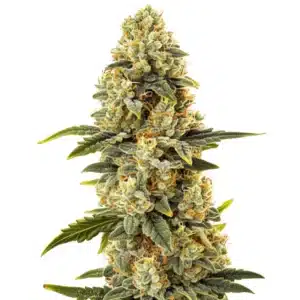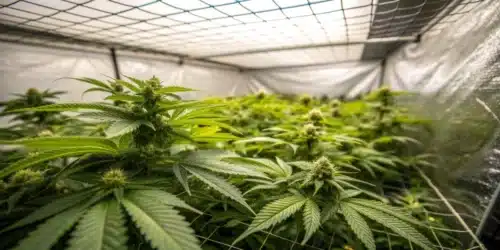Honey Buns Weed Strain Description
Honey Buns Weed Strain is a highly cherished hybrid cannabis variety known for its sweet, honey-infused flavor and euphoric effects. This strain, resulting from the cross between Gelatti and Honey B, perfectly blends both Indica and Sativa characteristics, offering a balanced experience that captivates both recreational and medicinal users.
Recommended Strains
Honey Buns
 THC: 23% - 27%
THC: 23% - 27% Type of seed: Feminized
Type of seed: Feminized Phenotype: Mostly Hybrid
Phenotype: Mostly Hybrid Day to flower: 8 - 9 weeks
Day to flower: 8 - 9 weeks
Honey Buns presents dense, light green buds adorned with amber hairs and a thick frosty layer of trichomes, giving it a visually appealing and resinous look. The aromatic profile of this strain combines sweet notes of honey and vanilla with earthy undertones, creating a distinctive and memorable experience. With a high THC content ranging between 23% and 27%, Honey Buns offers potent effects that leave users relaxed, euphoric, and happy.
Promos & Deals
Environmental Requirements for Growing Honey Buns
To achieve the best results when growing Honey Buns Weed Strain, it is essential to understand its environmental requirements. This strain thrives in a temperate climate with daytime temperatures between 70-80°F (21-27°C) and slightly cooler nights. Maintaining a stable temperature and humidity level is crucial to prevent stress and promote vigorous growth.
For indoor cultivation, Honey Buns requires high-quality LED grow lights or HPS lamps for optimal photosynthesis. During the vegetative stage, a light cycle of 18-20 hours per day is recommended, while switching to 12 hours of light and 12 hours of darkness will initiate the flowering stage. Providing consistent light exposure ensures the plants develop large, resinous buds.
When cultivating outdoors, Honey Buns needs a sunny location with plenty of natural light. Late September to early October is typically the best time to harvest this strain outdoors. If grown in cooler climates, it may be beneficial to use a greenhouse to provide extra protection and extend the growing season.
Setting Up The Growing Cannabis Space
Indoor Cannabis Cultivation
For indoor growing, setting up a well-organized space is essential to promote healthy Honey Buns plants. Choose a suitable grow tent or dedicated grow room that has ample space for vertical growth. Proper ventilation is necessary to ensure a continuous supply of fresh air, preventing mold or mildew. An efficient exhaust system with a carbon filter will help maintain optimal air quality and control odors.
Honey Buns Weed grows well in both soil and hydroponic setups. Using high-quality soil enriched with organic nutrients will enhance the flavor profile of the buds, while a hydroponic system can lead to faster growth and higher yields. Ensure that the pH level of the growing medium remains between 6.0 and 6.5 for ideal nutrient uptake.
Outdoor Cannabis Cultivation
When cultivating Honey Buns Weed Strain outdoors, select a location that receives plenty of sunlight throughout the day. The soil should be well-draining and rich in organic matter to promote root health. Growing in large containers or fabric pots can help regulate soil quality and allow better control over the growth environment.
Support structures like stakes or trellises are recommended to prevent branches from breaking under the weight of the dense buds. Additionally, protect the plants from strong winds by positioning them near a fence or other windbreaks.

Propagation and Germination of Honey Buns
Successful germination and propagation are crucial for healthy and vigorous Honey Buns plants. Start by selecting high-quality feminized seeds from a reputable source to ensure genetic stability and high germination rates.
To begin the germination process, soak the seeds in distilled water or wrap them in a damp paper towel for 24-48 hours. Ensure the environment is dark and the temperature is between 70-85°F (21-29°C). Once the seeds have developed taproots, carefully transfer them into a pre-moistened growing medium, such as seedling trays or small pots filled with light, well-draining soil.
Keep the seedlings in a warm and humid environment with gentle airflow. Maintaining a temperature of 75-80°F (24-27°C) and a humidity level of 60-70% will encourage rapid root growth. Provide indirect light for the first few days, gradually increasing light intensity as the seedlings mature.
Vegetative Phase of Honey Buns Weed Strain
During the vegetative phase, Honey Buns plants need ample light, nutrients, and proper care to develop into healthy and robust specimens. A light schedule of 18-20 hours per day is ideal, using LED grow lights or HPS lamps to provide the necessary light spectrum for growth.
Fertilizers with a higher nitrogen (N) content should be used during this phase to support vigorous leaf and stem growth. It is important to follow the manufacturer’s recommendations and closely monitor the plants for any signs of nutrient deficiencies or excesses.
Water the plants when the top inch of soil feels dry to the touch, ensuring not to overwater. Letting the soil dry slightly between watering sessions promotes strong root growth. Training techniques, such as topping or low-stress training (LST), can be used to control plant height and encourage a bushier growth pattern, resulting in higher yields.
Flowering Phase of Honey Buns Weed Seeds
The flowering phase of Honey Buns is when its signature buds begin to form, and the plant’s unique aromas become more pronounced. Switching to a 12/12 light cycle (12 hours of light and 12 hours of darkness) is required to initiate flowering. This phase usually lasts for 8-9 weeks, depending on growing conditions.
Transition to a bloom-specific nutrient formula that is higher in phosphorus (P) and potassium (K) to support bud development and enhance terpene production. Maintaining temperatures between 65-75°F (18-24°C) and humidity levels around 40-50% will help minimize the risk of mold and encourage resin production.
Providing adequate support, such as stakes or netting, is crucial during this stage, as Honey Buns develops dense and weighty buds that can cause branches to bend or break. The appearance of milky trichomes, along with some amber trichomes, is a good indicator that the plant is ready for harvest.
Cannabis Fertilization and Nutrition
Nutrient management is key to maximizing the growth and yield of Honey Buns Weed Strain. Using cannabis-specific fertilizers that contain a balanced mix of nitrogen (N), phosphorus (P), and potassium (K) ensures the plants receive essential nutrients throughout their life cycle.
During the vegetative stage, increase nitrogen levels to promote strong leaf and stem growth. As the plant transitions to flowering, switch to a bloom fertilizer with elevated phosphorus and potassium content. Monitoring the plants for nutrient deficiencies or toxicities will help you adjust the feeding regimen accordingly. It is also advisable to flush the plants with plain water during the last week of flowering to remove any residual nutrients that could affect bud flavor.
Pest and Disease Control for Cannabis Growing
Honey Buns Weed Strain is relatively resilient but can still be affected by common cannabis pests and diseases. To protect your plants, it’s important to implement preventive and corrective measures.
Prevention
- Inspect your plants regularly for early signs of pests, such as spider mites, aphids, or thrips.
- Maintain a clean growing environment, removing dead leaves or plant material that could attract pests.
- Introduce beneficial insects like ladybugs to help control pest populations naturally.
- Ensure proper airflow and reduce humidity levels to minimize the risk of mold and mildew.
- Quarantine any new plants before introducing them to your main growing area.
Corrective Actions
- If pests are detected, use organic pest control solutions formulated specifically for cannabis to minimize harm to the plants.
- For fungal issues like powdery mildew, remove infected plant material and use organic fungicides as necessary.
- Consider consulting with professional growers for advice if an infestation becomes severe.
Harvesting and Curing for Cannabis Growing
Harvesting Honey Buns Weed Strain at the right time ensures maximum potency, flavor, and overall quality. Use a magnifying glass to examine the trichomes on the buds; when they turn milky with a few amber ones, it’s time to harvest. Cut each branch carefully, making sure not to damage the buds, and remove large fan leaves.
Drying the buds in a dark, well-ventilated area at 60-70°F (15-21°C) with 50-60% humidity is key to preventing mold. Once dried, the buds should be placed in airtight jars and cured for 2-4 weeks in a cool, dark environment, opening the jars periodically to release excess moisture.

Is Honey Buns Weed Strain Indica or Sativa?
Honey Buns Weed Strain is a balanced hybrid, consisting of 50% Indica and 50% Sativa genetics. This blend results in a well-rounded experience, combining the relaxing and body-soothing effects of Indica with the cerebral stimulation and uplifting qualities of Sativa. Its balanced nature makes it an excellent choice for those seeking versatile effects that are suitable for any time of day.
Advantages of Growing Honey Buns Weed Strain
- High THC levels ranging from 23% to 27%.
- Balanced hybrid effects suitable for different occasions.
- Rich terpene profile with sweet, honey, and vanilla flavors.
- Good resistance to pests and diseases.
- Adaptable to both indoor and outdoor environments.
Disadvantages of Growing Honey Buns Seeds
- Requires odor control during the flowering phase due to strong aroma.
- Needs support for branches during flowering to prevent bud damage.
- May require precise nutrient management to avoid nutrient burn.
Why Buy Honey Buns Weed Strain
Honey Buns Weed Strain stands out for its unique combination of flavor, aroma, and balanced effects. It offers a delightful smoking experience with its sweet honey and vanilla notes, making it highly popular among cannabis enthusiasts. The strain also provides significant medicinal benefits, such as anxiety and pain relief, and is suitable for both beginners and experienced growers due to its moderate growth difficulty and adaptability to different environments.
Problems in Cultivating Honey Buns Weed Seeds
Like any cannabis strain, growing Honey Buns can come with its challenges. Proper nutrient management is essential, as incorrect feeding can lead to deficiencies or nutrient burn. Additionally, Honey Buns can emit a strong aroma during flowering, requiring growers to implement odor control measures. High humidity or poor ventilation can increase the risk of mold or bud rot, making environmental control crucial for success.
Similar Strains to Honey Buns
- Gelato #33: Known for its sweet and fruity flavor profile and balanced hybrid effects, making it comparable to Honey Buns.
- Zkittlez: Offers a blend of sweet, candy-like flavors with a relaxing and uplifting effect.
- Wedding Cake: A popular strain with vanilla undertones and balanced hybrid genetics that provide both mental stimulation and physical relaxation.
Tips for Professional Growers
- Implement advanced training techniques like Screen of Green (ScrOG) to maximize yields and control plant height.
- Use CO2 enrichment in the grow room to enhance growth rates and bud production.
- Invest in high-quality nutrients and maintain a strict feeding schedule to ensure optimal plant health and maximize potency.
FAQs About Honey Buns Weed Strain
What is the THC content of Honey Buns Weed Strain?
Honey Buns Weed Strain has a high THC content, ranging from 23% to 27%, providing potent effects that are both relaxing and euphoric.
Is Honey Buns Weed Strain suitable for beginners?
Yes, Honey Buns is suitable for beginners due to its resilience and adaptability, though some experience in nutrient management can help achieve the best results.
How long does it take for Honey Buns Weed Strain to flower?
The flowering period for Honey Buns typically lasts 8-9 weeks, depending on the growing conditions and environment.
What flavors can I expect from Honey Buns Weed Strain?
Honey Buns Weed Strain offers a sweet flavor profile, with dominant notes of honey, vanilla, and earthy undertones, making it a flavorful choice for cannabis connoisseurs.
What are the effects of consuming Honey Buns Weed Strain?
The effects of Honey Buns include relaxation, euphoria, and happiness, making it a versatile strain suitable for both recreational and medicinal use.
















